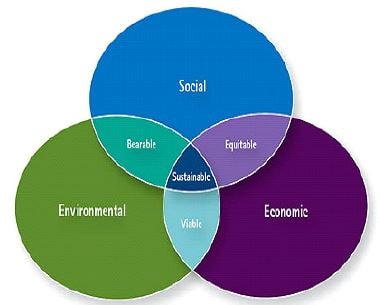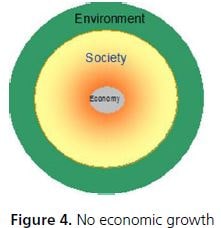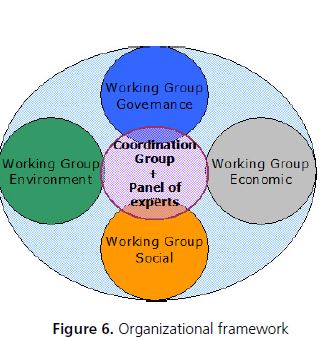CASE STUDY 5. INDICATORS FOR THE SUSTAINABLE MANAGEMENT OF COASTAL LAGOONS AREAS
P. Avila Zaragoza
Agencia de Gestion Agraria y Pesquera de Andalucia Consejeria de Agricultura, Pesca y Medio Ambiente. Coordinator of WGS-CAQ, Spain
Introduction to sustainability
Sustainability and sustainable development are terms that are becoming very common in any kind of issues and situations. Definitions can be found from many sources, some of the most significant of which are reported below.
Our Common Future, also known as the Brundtland Report, from the United Nations World Commission on Environment and Development (WCED) was published in 1987 (WCED, 2007). Multilateralism and interdependence of nations in the search for a sustainable development path were declared as the main tasks. Special attention was set on environmental issues, to be placed firmly on the political agenda, in order to discuss environment and development as one single aspect.
From this report, Sustainable development is simply "development that meets the needs of the present generation without compromising the ability of future generations to meet their own needs"
The publication of Our Common Future and the work of the World Commission on Environment and Development laid the groundwork for convening the 1992 Earth Summit and the subsequent adoption of Agenda 21 and the Rio Declaration, as well as leading to the establishment of the Commission on Sustainable Development.
The UN Rio Convention 1992, Conference on Environment and Development, set up the Principles of Sustainable Development, and introduced the concept of a “Global perspective for a Global problem” together with the strategy of “think globally, act locally”. This was applied to Agenda 21, in which the adaptation of Principles to the local context and needs was proposed, and the three pillars of sustainable development were defined: economic growth, social justice and environmental preservation.
All this lays down an ecosystems-based view of sustainable development that focuses on the maintenance of ecosystem stability and resilience. Sustainable development recognizes the interdependencies of human economies with their environment, and highlights the need for scientific understanding of ecosystem functioning and changes, as well as the effect on society.
Dimensions of sustainability
Figure 1 represents the three pillars or dimensions of sustainability. A global perspective forces the consideration of those three aspects and their interdependence.
Equilibrium must be achieved among them in order to reach sustainability.
There are other representations of the pillars as in the figures 2 and 3 below (F. Simard, based on O’Connor, M. 2006).

Figure 1. Pillars of sustainability

Figure 2. Equilibrium among dimensions of sustainability
Figure 3. Extreme economic growth. Non sustainable situation
Here, the circles are contained in each other, taking into consideration their dimensions and the pressure among them, that is: economy is generated by society taking resources from the environment; the growth of one of them will always put pressure on the others from the centre to the edges. Extreme situations, such as uncontrolled economy growth (Fig. 3), will increase the pressure of society on the environment, to reach a non-acceptable environmental situation, which is not convenient.
On the contrary, no economic growth (Fig. 4) will cause a social crisis, and only a small percentage of the population will benefit from the economy. Although the environment will benefit from this situation, it will not be economically viable and socially inequitable, therefore unsustainable.
Equilibrium must be achieved to gain sustainability. Figure 1 shows the best situation where the idea of governance is included and affects all dimensions (or pillars) of sustainability.

Figure 4. No economic growth
The concept of governance was developed and considered as a key issue for sustainable development at the World Summit on Sustainable Development in Johannesburg 2002. Stakeholders? involvement and public-private partnerships were pushed forward through the evolution of the institutional system (a set of rules and methods) and the strength of the actors’ capacity to participate on decision-making processes through collective learning issues and empowerment.
The principle, criteria and indicators (PCI) approach
The PCI approach for sustainable aquaculture has been defined according to a hierarchical nesting process, which makes it possible to link the indicators to the general principles of sustainable aquaculture (Rey-Valette et al., 2008). According to Rey-Valette et al., the process goes from a global vision to particular issues related to the four dimensions of sustainability, as reported hereunder. Following a sequential process, principles are defined considering the main issues related to sustainability. These principles are then expressed through criteria, which are the variables that explain those principles. Finally, indicators are developed to measure those variables in the form of indices and threshold values, which depend on available information and on the social acceptance of the standards.
Some definitions are needed to understand the process:
Principles: From Latin “principium” defined as “what serve as a basis”, for the action to be taken towards an objective of sustainability. Principles should have a general scope and acceptance, they should be considered as a rule or habit and be formulated as short statements, with action verbs originated from management vocabulary such as contribute, ensure, adapt and strengthen.
General Principles are adapted according to the specific needs of the context and to the application scale in order to facilitate ownership and implementation.
Criteria: Considered as a second-order principle or a standard rule or test on which a judgment or decision can be based. Criteria help to break down Principles into several homogeneous elements to link with the characteristics of the system, so they help in understanding the principles. Criteria should have a more specific scope related to the issues, they should identify variables and should be formulated by expressing the degree or state of the variable i.e., level of, control of, existence of, access to and capacity of.
Indicators: They are considered as a simple way to express the information related to a variable or a process. They are “communication tools which serve to quantify and simplify information in order to make it comprehensive to a targeted audience. They are tools to assist monitoring, evaluation, forecasting and decision-making. They are defined with reference to previously-set objectives; comparing the value shown by an indicator with the corresponding objective helps to judge whether an action is effective” (Madec, 2003). Indicators illustrate the variation observed according to the available data, they help to simplify and standardise information.
PCI approach: conceptual framework
A summary of the concepts and definition of the system, when talking about the PCI approach and in the case of lagoon areas, is shown below on figure 5. From an upside down tree structure, Principles represent objectives towards sustainability, several criteria can be developed for each principle, identifying the variables that will serve as a diagnosis of the system. Criteria are described and measured by one or more indicators, based on data from the system.

Figure 5. PCI approach: conceptual framework
Indicators for the sustainable management of coastal lagoons areas
The development of indicators for the sustainable management of lagoon areas is not an easy task, due to the complexity of the system and the numerous activities that take place in coastal lagoons and surrounding areas. Some aspects have to be considered in order to achieve sustainability not only on the aims and results, but also on the methodology itself.
A co-construction process should be implemented, in which all the inputs from stakeholders have to be taken into consideration, and which should be based on a participatory approach to gain from all possible actors directly or indirectly related to the activity and assure the acceptability of the project. Consensus among all stakeholders in the definition of objectives, methodology and expected results has to be achieved prior to the development of indicators.
In order to focus and help on the identification and definition of principles, criteria and indicators, an ecosystem-based approach should be considered to facilitate dialogue and consensus among parties. If a common interest and priority is identified for all users, the process will be easier and the success will be assured.
Methodology associated to the process
Taking into consideration the complexity of the surrounding environment of the lagoon areas, a multidisciplinary approach should be implemented, to simplify procedures and, gaining from previous experience (GFCM, 2011); the methodology could be developed in various steps or phases:
Phase I: descriptive
It is necessary to know and identify all the elements that benefit from the ecosystem. In this case there will be different categories such as:
• Stakeholders: All possible users of lagoons areas, apart from aquaculture producers and fishers, should be identified, that is: researchers, ONGs, general public, administrative bodies with competences on the environment (as they are the decision makers and responsible for management). Their needs and interests in connection with the ecosystem should also be defined.
• Uses and activities: All activities and uses of the ecosystem should be identified and linked to the stakeholders. Special attention should be given to capture fisheries and aquaculture; but other activities such as tourism, industry, agriculture, hunting and so on, should be described as part of the system.
• Environmental conditions: All the specific biological, hydrodynamic and geomorphologic characteristics of the environment should be identified, in order to establish the ecological status of the lagoons and surrounding areas.
• Interactions: The relationships between aquaculture producers and fishers should be identified, as well as with the rest of stakeholders and their activities. Positive and negative interactions should be described and taken into consideration.
All this information should be gathered and placed on a GIS, not only as a data base, but also as a communication tool. It has been proven by experience (Macias et al., 2003; Aguilar, 2006) that GIS is useful to facilitate dialogue, offering to all stakeholders the same information in a rational way, triggering participation and common understanding of the different situations.
Phase II: co-construction, PCI approach
This is the base to build up indicators for the sustainable management of lagoon areas. As it has been mentioned, the PCI approach should be implemented taking into consideration the four pillars of sustainability and through the following steps:
• Identification of principles as objectives of sustainability. From existing sustainable management reference frameworks, such as the Rio Conference, principles should be established and agreed upon among all parties;
• Identification of Criteria as variables to describe the principles. From the database and collected by experts for the four dimensions of sustainability with direct relation to the relevant principles;
• Identification of Indicators to measure the variables. Indicators should be validated according to attributes. Existing standards and reference points should be considered for quantitative and qualitative indicators and described for those that are not identified yet.
The process of identification of indicators is not an easy issue. Prioritisation and a selection of a minimum number of indicators is needed; equilibrium among the number of indicators per dimension of sustainability is recommended.
Phase III. Indicators assessment
Indicators should be tested and performance evaluated to validate, not only the indicator itself, but also the method for calculation and the reference values. Those should be associated to either a critical or an optimal state, where the former identifies a limit to be avoided (limit values) and the latter a target to be attained by the system (target values). Assessment should be performed through specific case studies and real application of indicators in order to become quality management standards.
Phase IV. Implementation and feedback
Indicators should support the decision-making process by describing the pressures affecting the ecosystem, along with the state and evolution related to the activities. Indicators should be a communication tool for all observers. For those purposes, several methods can be implemented, but one of the most visual, simple and straightforward is the Traffic-light Approach (TLA) (Ceriola, 2008). TLA is the representation of the state of the ecosystem through the values of the indicators, directly linked to colours, that is: positive = green, intermediate/neutral = yellow, negative = red.
Based on the colour code, the variations of each indicator can be highlighted and information is translated and made available in an easy way to set up objectives and new management decisions.
Boundaries, as well as minimum and maximum values for indicators, should be previously established.
Organizational framework
The PCI approach and the development indicators are multidisciplinary issues. Working groups should be established and participation of all stakeholders should be motivated. A panel of experts on economics, biological and social sciences and governance should carry out supervision of the performance of the groups as well as of the outputs, as sustainable management relies on the four pillars of sustainability. Figure 6 shows an example of an organizational framework for the identification of indicators .

Figure 6. Organizational framework
Conclusions
Coastal lagoons areas are considered as ecosystems of high interest from the environmental, social and economic point of view. Indicators for the sustainable management of coastal lagoon areas are a tool of communication among all stakeholders and users of the system as well as a means to evaluate the performance of the activities towards sustainability.
Methods and tools to develop indicators are available, such as the PCI approach, which gives consistency to the whole process as well as the participative and co-construction approaches that ensure acceptability and allow the achievement of consensus. A panel of experts on the different dimensions of sustainability is required in order to help all participants in the understanding of the system.
References
Aguilar, M., Marco, J.J., Macias, J.C., Lozano, I., Acosta, D. & Alamo, C. 2006. Zonas idoneas para el desarrollo de la acuicultura en espacios maritimo-terrestres de Andalucia. Consejeria de Agricultura y Pesca, Junta de Andalucia. SE-1451-06. 133 pp.
Ceriola, L., Accadia, P., Mannini, P., Massa, F., Milone, N. & Hungaro, N. 2008. A bio economic indicators suite for the appraisal of the demersal trawl fishery in the Southern Adriatic Sea (Central Mediterranean). Fisheries Research, Fisheries Research, 92: 255–267
GFCM. 2011. Indicators for the sustainable development of finfish Mediterranean aquaculture: highlights from the InDAM Project. Studies and Reviews. General Fisheries Commission for the Mediterranean No. 90 Rome, FAO. 218 pp.
Macias, J.C., Del Castillo, F. & Alamo, C. 2003. Zonas idoneas para el desarrollo de la acuicultura en el litoral andaluz. Consejeria de Agricultura y Pesca, Junta de Andalucia. 180 pp.
Madec, P. 2003. Les indicateurs de developpement durable. INRA-Universite de Montpellier II. 118 pp.
O’Connor, M. 2006 The “Four Spheres” framework for sustainability. Ecological complexity, 3: 285–292.
Rey-Valette, H., Clement, O., Aubin, J., Mathe, S., Chia, E., Legendre, M., Caruso, D., Mikolasek, O., Blancheton, J.P., Slembrouck, J., Baruthio, A., Rene, F., Levang, P. & Morissens, P. 2008. Guide to the co-construction of sustainable development indicators in aquaculture. EVAD project. Montpellier, France, Cirad. 144 pp.
WCED. 1987. Our common future. A global agenda for change. New York, Oxford University Press, xv. 400 pp.